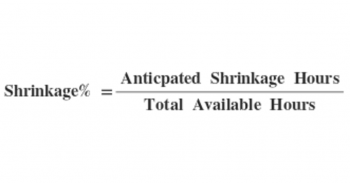Call center shrinkage refers to the time for which agents are paid to answer calls and serve customers versus the actual time they spend doing so. The difference between the two is shrinkage. It tells you how much time agents spend doing something other than helping customers.
Shrinkage comes from both internal events that you can control and external sources you cannot. Assigning agents to a training program, asking them to attend meetings, and planned system maintenance down times are all examples of internal events under your control. On the other hand, vacations, break times, meal times and personal time off (PTO) days—whether mandated by labor law or company policy— can all be considered outside your control as the call center manager. Time absent from work for illness are impossible to predict and also qualify as external events.
There are several ways to calculate the number of agents you need to handle a specific call volume. With the exception of only a few Erlang calculator tools, most forecasting tools do not take shrinkage into account. That can lead to under-staffing, long average times to answer, increased abandonment rates and drops in customer satisfaction. Thus, you can think of shrinkage as an adjustment, a “correction factor,” that you apply to your forecast to avoid those problems.
How to Calculate Call Center Shrinkage
Decide on a period of time you wish to forecast—a day, week, month, quarter or a period that coincides with an external event such as the launch of a new product. (Generally, calculating shrinkage over a forecast period much longer than a calendar quarter can allow error to slip in. Most call centers do not run with a flat call volume all year long. Seasonal and other events create ups and downs, so it’s wise to forecast for periods that you expect to have reasonably flat, or at least predictable, demand.)
– Once you’ve prepared your forecast, gather the following data for that same period of time and make the calculation.
– The total amount of shrinkage you anticipate, in minutes or hours, depending upon the length of the measurement period, from both internal and external sources.
The total amount of time during that period for which you pay agents to actively help customers.

How to Fix Call Center Shrinkage
The impact of shrinkage on cost of operation can be dramatic. For instance, a call center with only 25 agents who each contribute 20 minutes of shrinkage each day would cost you 500 minutes per day, or 8.33 hours. With an average salary burdened with benefits at $15 per hour, that’s $125 per day or more than $32,500 per year based on a five-day work week…and over 2,100 hours lost to customers seeking help.
You can tackle the shrinkage issue from two directions. The first uses sound human resource management principles, the second, technology.
The HR approach asks that you set expectations for your team that align with the company’s objectives. One such expectation is that every agent will clock in or log in on time for each shift. Agents whose attendance and adherence to scheduled work hours falls short need to be counseled and managed.
As “Tips for Improving Call Center Agent Performance” explains, using HR best practices and modeling the behavior you expect keeps your team engaged and motivated.
Looking at technology solutions, any of several can help minimize shrinkage.
– Workforce management software (WFM) can automate the forecasting process, often giving superior accuracy over spreadsheet approaches. WFM can also assist with scheduling agents, and some products even allow agents to schedule their own shifts within boundaries management defines. That feature, in itself, can give an agent a sense of autonomy that can be motivating. Some WFM software with skill-based routing capability can further enhance call center operation, which also improves the work experience for agents.
– Interaction analytics software can be used to enhance the quality and efficiency of a call center operation. Such software processes the interaction between the customer and the agent, and points out areas where additional training can improve the quality and efficiency of customer interactions.
– System level call center applications can reduce shrinkage as well as other inefficiencies by monitoring agent performance. Agents who are over utilized for an extended period will experience greater stress levels, which will eventually lead to diminished performance, increased employee turnover and the attendant increased expenses of operation, and reductions in customer satisfaction. Other agents, however, may fall prey to boredom when under utilized and are often prone to leave for another job that gives them a more visible upward career path.
Shrinkage is part of the cost of doing business and cannot be eliminated, but these tactics and strategies will give you more control over agent performance and adherence to work schedules at your call center.
This article was originally published on the RDT blog and was reprinted with permission.



